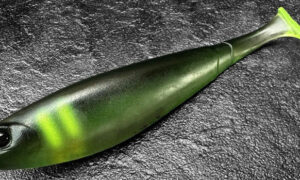
The Damiki Rig came to national attention at the 2017 Bassmaster Elite at Cherokee, TN, but TN bass-heads were onto it way before that. One of those dudes was Elite pro David “Doomsday” Mullins, who gave us the down-low on what it is and how to fish it.
History
> “It started on South Holston — not sure who started it. They were catching them 100′ deep at times. Friends showed me how to do it there, we took it to Cherokee and there you go. …by the time the Elite came to Cherokeee everybody knew about it. If the no-info rule was like it was now, me or Ott would’ve won it by 10 lbs.”
The Rig — which ain’t really called the Damiki Rig no mo’
> “It’s a shad-type bait that you put on some sort of jighead — usually the jighead weights 1/4- to 3/8-oz. …spinning tackle and light line — 6-8 lb line, and it’s designed to be fished vertically.
> “…mostly fall-winter…when the water starts cooling down. It’s totally a shad-mimicking deal. In our lakes those shad in the wintertime get so lethargic, they’ll be lifeless — not much movement at all to ’em…. That’s what it’s mimicking. The bait has no action.
> “You want it to hang horizontal — you don’t have to have special jighead for it. You can take a ball head jighead, but just make sure your knot is where it makes the bait vertical.
> “I used a custom [jighead] for a long time. Now Scottsboro’s making it [the Hellfire Finesse Swimbait Head]. It’s a screw-lock ballhead with a 3/0 light wire hook in it. It’s just about perfect for what you need.
> “Some people are getting more natural, like painting it white and adding an eye to it. But you still catch ’em fine with a regular ballhead.
> “The Damiki Armor Shad is what we all used — it’s like a 3″ little shad that represented what the forage looked like at that time. Now the Doomsday C Shad — stands for “Cherokee Shad”…we made that lure from a picture of a shad….
> “Now it’s called ‘droppin’ to ’em’ — now that’s the term that’s used.
> “I like the [Doomsday] C-Shad. When the water’s colored I like ‘pearly white flash,’ and when it’s clear I use ‘pearl blue flash’ — it’s a little bit more natural.
> “Rig it in the nose with hook exposed. I like a screw-lock jighead but you don’t necessarily have to have one. Or you can use a wire keeper. [With a keeper of some sort] you can use pretty much one bait all day.

> “…7-lb Sunline Sniper fluoro. You can go braid to fluoro, but if it’s winter time and it gets cold that braid freezes up a lot easier than straight fluoro. If I’m using braid, it’s 12-lb Sunline SX1.”
Rod is a 7′ 3″ ML Doomsday Tackle Spinning Rod:
> “…no action imparted to it. You could literally leave your rod on the deck of the boat and still catch ’em on it.”
Where and how to drop to ’em
> “When I first started doing it the only thing I looked for was some sort of cover. Usually on our [highland] lakes it’s rock. This technique doesn’t work everywhere — seems like it works in highland reservoirs that have shad.
> “I’d idle and look for pieces of rock or isolated cover…wouldn’t necessarily look for fish because in winter lot of times the fish’ll get so tight to the bottom you can’t graph them. Look for rocks, stumps, any sort of cover — usually at a deeper depth, so 20-40′ on my lake but it can be deeper like at Holston.
> “Once you find cover, mark it and put your trolling motor down. Drop that bait and watch it on your graph the whole way til you get 2-5′ off the bottom. Stop it — you’re hovering that bait. Let the wind and/or trolling motor drift you over top of that hard cover or structure.
> “All of a sudden a streak will come off the bottom and get your bait. Very often those fish have mud on their bellies they’re so tight on the bottom. It’s a thump — they bite it pretty hard, always have.
> “I’ve seen them bite it in the fall when the water temp is in 60s, but it seems like it starts excelling when it’s in the 40s and 50s. It’s like a dying baitfish type of deal.
> “Now a lot of guys are looking for schools of fish more than isolated cover. If you get around bait — balls of shad — you’ve always got smallmouths around it at home. We catch 95% smallmouths on it…some largemouths.
> “On Cherokee depressions are real key. The shad migrate to depressions and flats.”
> How long to give a spot: “Usually not long. It depends on how big the structure is. Your trying to make a pass over the whole structure. If it’s a rockpile 20 yds long, you’e trying to cover that whole 20 yds. If it’s a flat piece, you might just fish it one time. If a piece of structure falls quick, I might fish it at 20′ and then maybe at 35′.
> “Don’t stay a long time if you don’t see fish rising up [on your electronics]. You can’t make them eat it — they need to be hungry.”
More
> Will it work for smallmouths other times of the year: “I tried it at the St Lawrence, but the water’s so clear it seems like they get such a good look at it they don’t bite it as well.”



























